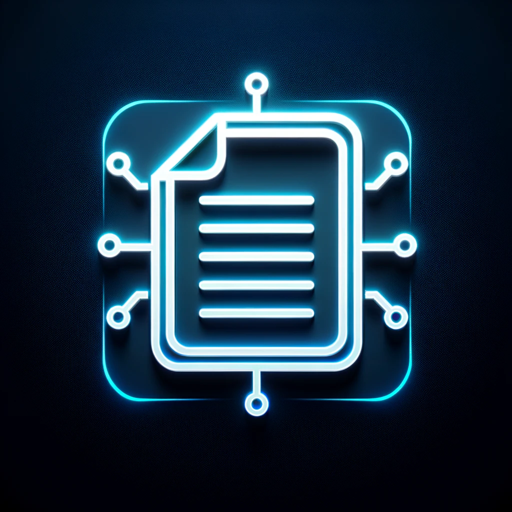Chain of Density - Article Summarization in JSON-dense entity-based summarization
AI-powered summaries that pack maximum detail.
Type {{article}} just as shown, paste your text, ENTER
Chain of Density: https://arxiv.org/pdf/2309.04269.pdf
Examples of when Chain of Density should be used
{{article}} random https://arxiv.org
Related Tools
Load More
Link Reader
Read any links: webpage, youtube, PDF, PPT, image, Word doc etc; OCR image; Search & browse web.
Link reader
Can process any link
TL;DR
Enter any URL and have the text content summarized for you!
News Article Summarizer
Enter the URL and I'll create a summary for you.

Summarizer
Summarize Chapters and Articles for Intuitive Absorption

Research Article Summarizer
I summarize any scientific article, focusing on key sections like methods and findings.
20.0 / 5 (200 votes)
Introduction to Chain of Density - Article Summarization in JSON
The Chain of Density (CoD) prompting is designed to optimize text summarization using GPT-4 by increasing information density through iterative steps. Starting with an entity-sparse summary, CoD adds specific, novel, and relevant details while keeping the summary length fixed. This method achieves a higher concentration of information per word without sacrificing clarity. The core aim is to improve the balance between informativeness and readability, making it ideal for scenarios where brevity and detail are both crucial, such as news summaries, academic abstracts, or concise reports.

Main Functions of Chain of Density - Article Summarization
Iterative Densification
Example
A user provides an 80-word news article summary. CoD progressively adds key missing details without expanding the word count.
Scenario
Journalists could use this to summarize breaking news articles in a way that incorporates evolving details over time, making reports more comprehensive.
Entity Extraction and Fusion
Example
During summarization, CoD identifies and merges multiple information sources (entities) into a shorter, unified sentence.
Scenario
Researchers summarizing lengthy scientific papers can use CoD to compress key results, methodologies, and conclusions into a brief, dense abstract.
Maintaining Length-Quality Balance
Example
Even as information density increases, CoD preserves readability by avoiding overwhelming the summary with excessive details.
Scenario
Businesses summarizing large market reports or analyses can use CoD to condense findings into actionable insights without losing essential data.
Ideal Users of Chain of Density Services
Journalists and Media Outlets
They can benefit from CoD by creating concise, entity-rich summaries of news articles. CoD helps them condense fast-evolving stories without losing key details, ensuring readers get high-quality, dense summaries.
Researchers and Academics
Scholars dealing with dense research papers can use CoD to create comprehensive abstracts. It enables them to fuse results and data points while maintaining the clarity and relevance of their research summaries.

How to Use Chain of Density - Article Summarization in JSON
Step 1
Visit aichatonline.org for a free trial without login, also no need for ChatGPT Plus.
Step 2
Input the article text you want summarized, ensuring it is in a suitable digital format.
Step 3
Trigger the Chain of Density prompt, starting with a sparse summary and gradually densifying it over five iterations.
Step 4
At each step, the model identifies missing entities and incorporates them into a denser summary without expanding word count.
Step 5
Export the final summary in JSON format to integrate into your workflow or use for reporting.
Try other advanced and practical GPTs
AI Diagram Designer: Smart Mind Map & Chart Maker
AI-powered tool for creating diagrams

WHU Startup Browser
AI-Powered Startup Discovery and Analysis

Scientific Writing
AI-powered tool for precise scientific writing

AI OCR
AI-powered OCR for seamless text extraction

HOOD Requirements Assistant
AI-Powered Clarity for Your Requirements

NAICS Explorer
AI-powered tool for NAICS code exploration.

Chess Mentor
AI-powered chess coaching

Astrologer GPT
Astrology insights powered by AI.

Photo Creator
Turn your ideas into photorealistic images with AI.

Business Insight Writer
AI-powered business insights made easy

Philosophy Sage
AI-Powered Philosophy Insight Tool

Training Manual Generator GPT
AI-powered training manuals tailored to your business

- Business Reports
- Research Papers
- News Summaries
- Marketing Analysis
- Legal Briefings
Q&A About Chain of Density - Article Summarization in JSON
What is the purpose of Chain of Density summarization?
The Chain of Density method is designed to generate increasingly detailed summaries by fusing missing information from the source text into each iteration without increasing the length of the summary.
How does Chain of Density handle entity selection?
It identifies relevant, specific, and novel entities in each iteration, adding them to the summary while preserving the original length through compression and abstraction.
What is a common use case for Chain of Density summarization?
This summarization method is especially useful for tasks that require high information density, such as news summarization, legal briefings, or research abstracts.
What makes Chain of Density different from standard summarization?
Unlike traditional summarization, Chain of Density focuses on iteratively increasing the information density by identifying and integrating missing entities while maintaining the original summary length.
Can Chain of Density be used for real-time applications?
Yes, its ability to produce highly compressed yet informative summaries makes it suitable for real-time or high-latency environments, such as news feeds or legal document summaries.